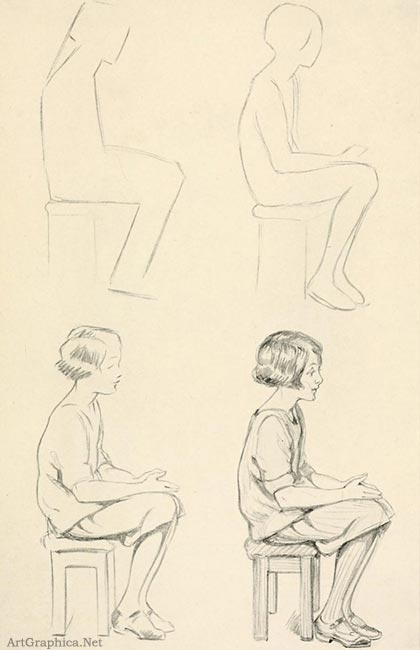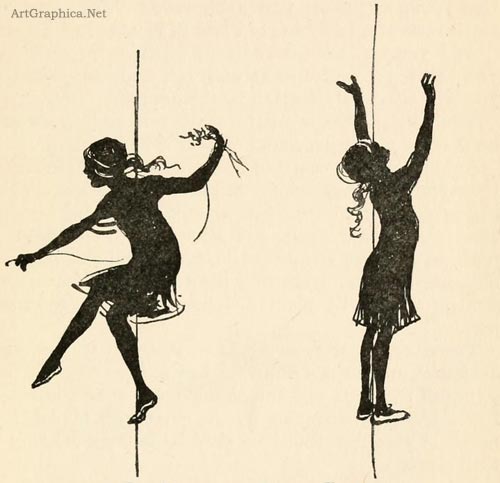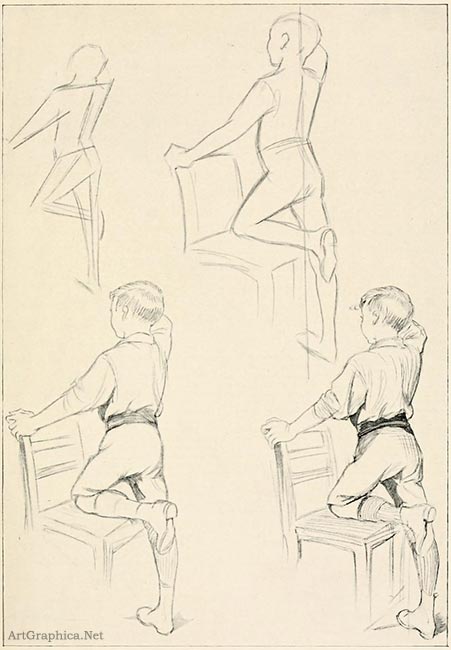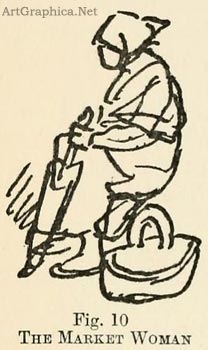Free Art Book - Drawing for Beginners
CHAPTER III
Drawing Ourselves and Others
WHEN we first try to draw each other it is best to choose fairly easy positions. Put your small brother into an exaggerated attitude--for example,
rushing toward you with arms outspread, his chin in the air. You will very soon get tired and discouraged ; worse still, so will he, and the probabilities are that his first posing will be his last.
So choose an easy position. Firstly for his sake, secondly for yours. It does not pay to be too selfish about these things, and posing, after all is said and done, is very monotonous work. Queer aches and pains develop in hands, knees, and feet. Extended arms holding banners or grasping trusty swords are apt to get heavy as lead. So I offer it to you as an invaluable principle, consider the feelings of your model.
By ' an easy pose' one that represents a simple position is meant. If we begin by trying to draw some one with body huddled together, legs crossed, neck twisted, and eyes gazing into ours, we shall soon be very confused.
Stand your brother upright, with his arms to his side ; or put your sister on a chair with her hands in her lap and her eyes looking before her ; or plump the baby down on a cushion on the floor and draw him sideways (he won't stay there, but that is a detail). Choose, in a word, easy positions.
It is a very encouraging reflection that all people who aspire to become artists are more or less in the same boat. We land on the same rocks, reefs, and shore, we battle with the same currents, tides, and storms. We should, therefore, be ready with a helping hand whenever it is required by others.
"I will sit to you if you will sit to me," my brothers would say. As there were two brothers and one sister, all fond of drawing, we formed a Triple Alliance, and posed to each other in turn.
So we will begin with simple poses.
A hint here as to the size of our sketches may not come amiss. Do not draw on too small a scale. A sketch of a figure the height of your thumb will not teach you very much. Moreover, one is too apt to adopt a niggling, worried style of drawing. Take a good-sized sheet of paper and try to make your sketch as large as the length of your hand.
Shall we assume that Kathleen has kindly agreed to sit to us for fifteen minutes ? Let us place her on a stool on which she can sit upright and in a steady suffused light--not too near the window, the fire, the electric, gas, or lamp light, all of which tend to throw confusing lights and shadows. Then we give Kathleen a searching look--not too long--and we ask ourselves what shape does Kathleen, roughly speaking, present ? She forms a triangular shape. Yes. See the line of the back, the line of the upper leg, the line of the leg from the knee to the foot, and the upright supports of the stool.
Having seen, we record our impressions--lightly--for after all they are but first impressions, and we don't want to make harsh lines that can be erased only by much rubbing and spoiling of paper.
Next we consider the angles we have made and compare with Kathleen. We see that the angles are softened into curves, the forward thrust of the neck, the curve of the spine and upper part of the leg. We might note the position of the hands on the lap (they are not on the extreme edge of the knee), and we could look again at the head and indicate the roundness of the upper side, the comparatively flat oval of the face, and the hood-like shape of Kathleen's short mane.
Now we are searching for more detail. I know you are dying to give her a nose, eye, and mouth. Well, trace these details lightly and do not labour the eyelashes--we have something more important in hand.
Next we might note the arm. Turn up the sleeve if the elbow is hidden. Hinges or joints are very important, and the more we see of them the better we shall understand the working of the human frame. Kathleen has a thin but shapely little arm, the upper surface of which is gently rounded and the lower straighter and firmer because of the bones beneath. The thumb rises to a point, and the fingers fall outward more or less in the shape of a fan. The position of this hand is very simple. But ten to one, if the pose has been left to Kathleen's choice, she has clasped her fingers tightly together, for that is a very natural thing to do with an unoccupied pair of hands. And clasped hands are very difficult to draw. One invariably makes them far too large. It is not easy to fit four fingers and a thumb on that small thing called a palm until we have gained experience.
Having arrived at the arms and hands we continue with the lower limbs, tucking in the skirt (folds can be very misleading) to show the upper part of the thigh. The square angle resting upon the seat of the stool is sharply defined. The knee is more or less hidden, but ask Kathleen to touch the knees where they bend, or hold the skirt tightly across the knees, and mark it well in your mind, or on your paper, because from there we trace the lower part of the leg.
Now we follow the curve of the leg, noticing the flat surface of the front part compared with the calf. Your Kathleen may not have as much calf as my Kathleen. Girls have very often the thinnest of arms and legs, and it is a common mistake to give too much flesh. Next we draw the feet. The boat- shape of the foot seen in profile (or sideways) is broken up with the strap, which marks also the thickest part of the foot, the instep. From that curve it descends steeply to the root of the toes or the curve of the shoe proper. Stout, sensible shoes has Kathleen, and the sole and heel are easily traced, marked as they are with the shadows of the leather.
Lastly, note the most important shadows and folds ; also the hair, neckband, cuffs, or doubled-back sleeves--just so far as your interest carries you, but no further.

Fig. 7. KATHLEEN
And so we have Kathleen down on paper. She deserves our thanks, and if she laughs, as she probably will, and exclaims, " Oh, how queer I look in your drawing ! " you can tell her that if she will only sit to us fairly often, we will improve and hope some day to make her as nice-looking as she would wish.

Fig. 8. THE BALANCING OR MOVING FIGURES
Now what about Jack--do you think he would care to sit for his picture ?
Jack being a gentleman full of frolic will probably like to pose in more or less spirited action. Why not ? If he wishes to peer aft across the good kitchen chair with his back toward us, we shall probably find it is no more difficult to draw him thus than from a side view. His energy may be a spur to ours.
There is one fact about standing figures that you must always bear in mind. They must balance.
You will probably say with a smile you are quite certain of that without any reminder. But I am inclined to think that young artists are very unobservant, or else uncommonly careless, so often do we note a lack of balance in their pictures.
And you can see for yourself, artist or no artist, that if you throw yourself into an attitude, and lose your balance, you will come with a crash to the ground.
Your heel, or toe, or whatever happens to be your support, must come under the centre of your spinal column.
In Fig. 8 are shown a couple of silhouettes of figures in action to emphasize this principle. Suppose you were hopping on one leg, or dancing on your toe, or standing upright with your arms above your head, and Michael or Peter gave you a push, as brothers sometimes do, you would at once lose your balance--and the figure in your drawing will overbalance if you do not rightly plant him upon whatever is to support him.
Therefore, as soon as we have sketched in the angles of Jack draw a faint line down the centre from the back or half- centre of the neck, and this should reach the ball of the right foot. (Jack is depending on the chair with his left leg, and he could therefore lean backward or forward without losing his balance.)
First we glean a general idea of the big angles of the body, and the broad, sweeping line of the spine, the bending thigh and leg, and the standing leg and foot (in my sketch drawn on a smaller scale). Then we follow the angles, and find they break into large simple curves. We trace the great curve of the body, its backward thrust, the width of shoulders, and the comparatively narrow width across the hips, the thick curve of the thigh and its narrowing line to where the knee bends on the chair, the curve of the calf, and the flatter line of the knee to the foot where it bends downward in a great spoon-shaped curve. The right leg has far more delicate curves. The calf and upper thigh are drawn taut with the very upright position. (If you stand in this position you can feel the strain of the sinews at the back of the knee and the ankle.) The ankle tapers and the toe of the foot is turned outward, and thus we see both the back of the heel and the broad toe turned away in shape something like the bow of a boat.
Having noted the main forms and their relation to each other, we can next devote ourselves to detail. The line of the hair follows the upper part of the round bullet-shaped head. The ear is valuable, coming as it does at the meeting of the jaw and skull, and we note the tiny niche where the neck rises above the collar.

Fig. 9. JACK
Now we can mark down the big shadows--under the loose sleeve of the shirt, at the waistbelt, between the legs and the folds at the back of the knickerbockers, at the knee, and beneath the heels. We follow the grip of the hand on the chair, remembering that something solid and big flattens and pushes out the palm. The uplifted right arm is turned from us. We can see--and it is all that we can see--the small apex of the bending arm, the round edge of the elbow as it bends upward and outward, the folds on the inner part of the sleeve, and the tips of the fingers resting on the brow. After which you can carry on with anything that holds your interest. But keep your sketch a sketch. Do not worry after details. You will learn more at this stage from making sketches of quick poses and getting a knowledge of general proportions than by delving after detail.
Also you could reverse the positions of Kathleen and Jack. Kathleen might stand in the same pose as Jack, and Jack might sit on the stool.
And it is very amusing to dress brother and sister in their elders' clothes.
Give Kathleen a shawl and a handkerchief folded three corner-wise and tied under her chin, put a basket at her feet, a closed umbrella in her hands, and we have an old market woman. Only remember that we bend with age, our head droops, our arms sag forward, and our toes very probably would turn in a little after long years of weary plodding.
It is amusing to play with one's fancy, to bring out our colour-box and make a fresh drawing, tinting clothes, hair, and face.
Put the old lady' against a plain background, a wall, for instance, and begin by sketching the whole figure (as we sketched Kathleen as herself). That is, the simple angles, the big curves, then the smaller shapes of head, face, arms, hands, shawl, apron, feet ; lastly, the details of hair, folds, features, fingers.
If you decide to colour your picture of the market woman, choose pleasing colours, tints that will blend pleasantly.
An old French peasant woman would be dressed probably in greys and blues, whereas a gipsy woman would have a highly coloured handkerchief and shawl.

Jack might dress up as a shepherd (with a long cloak or plaid across his shoulder, and a staff in his hand, and his knee on a rock) scanning the rough pasture ground for sheep that have strayed.
But beware !--draperies, cloaks, and plaids are very misleading.
We are inclined to ' lose ' the drawing of a leg, arm, or figure when we are trying to sketch draperies. The folds deceive the eye. The fall of a cloak may hide the position of a foot or an arm. If such is the case, then remove the drapery, make a note of the particular object about which you have doubts, and replace.
Should you prefer to leave the folds untouched because they are happily arranged, take a walk round your model and look at the hidden object from the opposite side. Never hesitate to survey the thing that you are drawing from a different angle. It is a common fault to worry over a detail, to labour a difficult problem, when a glance in another position would make everything perfectly plain.
To return to the shepherd.
The colouring of the old shepherd's clothes should be more or less decided by his surroundings. One would not for choice give him a scarlet plaid and a Prussian blue kilt. These colours would soon fly in the mists of early dawn, the long days of rain and storm. A shepherd's clothes would probably share the tints of the hills and of the heather--mauve, green, brown, and fawn.
Prev. Page
Drawing Toys
|












